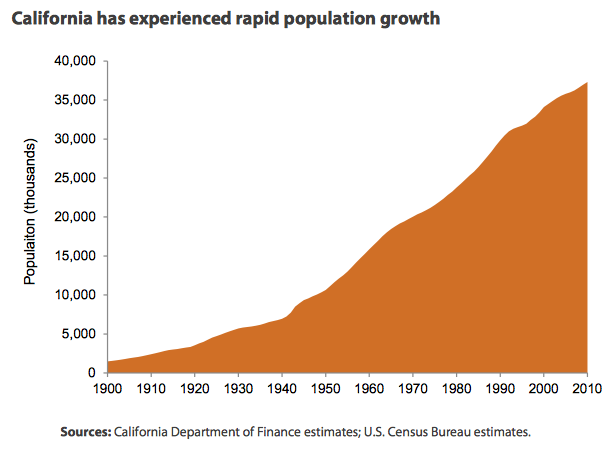Say good-bye to the open vistas of yesteryear; say hello to tracts of suburban housing from sea to polluted sea. There’s no surprise: As Washington has admitted millions of immigrants decade after decade, all the newbies need a place to live — or the Americans hope to flee to some undiverse community where English is still spoken.
Perpetual immigration comes with a big cost to American open spaces, which cannot be unpaved or restored to a pristine state. According to a report released this week concerning 11 western states, an area totaling 4,321 square miles was developed from 2001 to 2011.
Natural beauty is part of our national heritage, but it is being destroyed by extreme immigration. Plus California in particular has suffered from a terrible drought over the past few years, but nobody in government ever says population growth may well overwhelm the water supply.
America’s vanishing West: California losing most land to development, by Paul Rogers, San Jose Mercury News, May 17, 2016
![]()
The Oakhurst subdivision abuts open space in Clayton, Calif. (Contra Costa Times)
The natural landscape of the American West is gradually disappearing under a relentless march of new subdivisions, roads, oil and gas production, agricultural operations and other human development, according to a detailed mapping study released Tuesday.
From 2001 to 2011, an area totaling 4,321 square miles — or 15 times the size of San Jose, Oakland and San Francisco combined — was modified by development in the 11 Western states, the report found, with California losing the most natural land, and Wyoming and Utah changing at the fastest rate.
“We are nibbling away at our wild places at a fairly rapid clip,” said Mike Dombeck, former chief of the U.S. Forest Service and the U.S. Bureau of Land Management in the 1990s.
The report — at www.disappearingwest.org — was produced by scientists at Conservation Science Partners, a non-profit research organization based in Truckee, who spent a year analyzing more than 30 large databases and a decade of satellite images over Arizona, California, Colorado, Idaho, Montana, Nevada, New Mexico, Oregon, Utah, Washington and Wyoming.
Their conclusion: Every 2.5 minutes the West loses an area of natural land the size of a football field to human development. And each year, on average it loses 432 square miles, an area nearly the size of Los Angeles.
“Protecting wild places is a very conservative thing to do because it keeps options available for the future,” said Dombeck, now a board member at Conservation Science Partners. “Once you have a subdivision put in or roads built into a wild place, it’s almost impossible to turn back the clock.”
To be sure, vast areas of the West, from the Sierra Nevada to Utah’s Red Rock Canyons, the Olympic Peninsula and the Greater Yellowstone Area, are preserved in national parks, wilderness areas and other designations.
But only 12 percent of all the land in the 11 Western states enjoys such protections, the report found. The most is in California, where 24 percent of the state is protected, followed by Nevada at 14 percent and Utah at 13 percent. The least: New Mexico with 6 percent and Montana with 7 percent.
Careless development — whether it is sprawling new subdivisions outside Denver or Phoenix, or vast new oil and gas fields near towns like Pinedale, Wyoming—fragment the landscape, the report’s authors said, blocking corridors for wildlife, polluting water and changing the West’s singular sense of place.
“There are large landscapes that are still pretty healthy and somewhat protected because of years of conservation work in the past,” said Matt Lee-Ashley, public lands director for Center for American Progress, a left-leaning think tank in Washington, D.C. that funded the study. “But with continued rates of loss, we can’t think of that work being finished yet.”
In California, Inland Empire counties lost the most open land. At the top of the list was San Bernardino County, which lost 60,013 acres of natural land from 2001-2011, followed by Riverside, Kern, Los Angeles and San Diego. In the Bay Area, Solano County lost the most, at 10,883 acres, followed by Contra Costa at 10,610 and Sonoma County at 9,193. San Francisco, Marin and San Mateo counties lost the least, all below 1,600 acres, while Santa Clara lost 6,225 acres and Alameda lost 5,085.
The study did not account for new parklands created over the decade. Private land trusts and parks agencies around the Bay Area have preserved tens of thousands of acres in the past 15 years, from the Santa Cruz Mountains to wetlands ringing San Francisco Bay and the rangelands of the East Bay.
Lee-Ashley, a former deputy chief of staff to Interior Secretary Ken Salazar, said that the solution to preserve the broader West is for cities and states to pass zoning rules keeping development off sensitive areas, along with more funding from Congress to expand national parks and wilderness areas.
Over the past decade or so, Republican leaders in Congress, particularly members of the Tea Party movement, have blocked efforts to expand funding for parks and opposed President Obama’s use of executive power to establish new national monuments.
Some Western observers say the solution isn’t more federal money from Washington, D.C.
Private initiatives, like a long-standing program in which the Nature Conservancy pays rice farmers in California’s Central Valley to flood their fields in the winter to provide habitat for ducks and geese, are just as important if not more so, said Shawn Regan, a spokesman for PERC, the Property and Environmental Research Center, a free-market advocacy group in Bozeman, Montana.
“There’s a $12 billion maintenance backlog in our national parks,” said Regan. “We have all these public lands in the West, but we aren’t doing a very good job of taking care of what we have.”
Regan said private solutions include paying landowners to lease their water rights, buying development rights from landowners, and encouraging new agricultural technology, like genetically engineered crops, to allow farmers to produce more food per acre.
“We need more ways to work with private landowners, not against them,” he said. “And environmentalists often discourage ways to work with private landowners to encourage conservation.”
Paul Rogers covers resources and environmental issues. Contact him at 408-920-5045. Follow him at Twitter.com/PaulRogersSJMN















